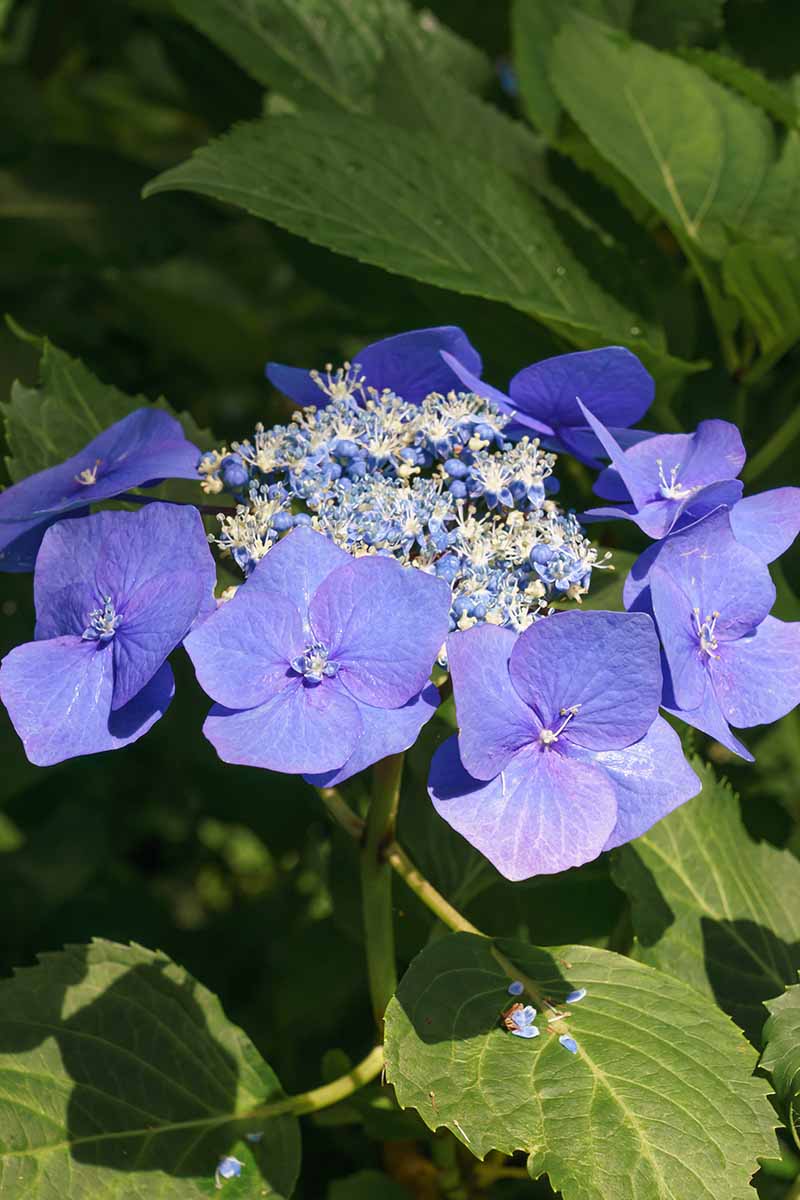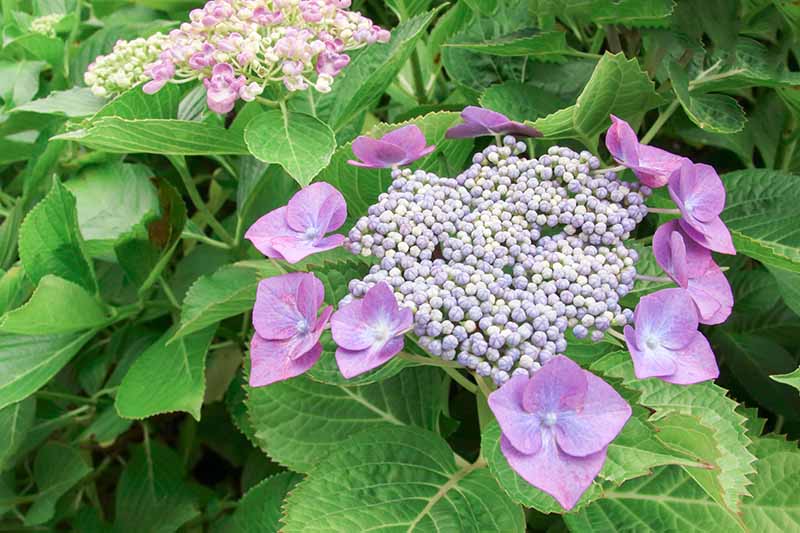If I were to ask you to describe a hydrangea, you might say that it’s a bush with blue, pink, or white flowers that grow in a ball shape, and you’d be absolutely right.
But that’s not the end of the story.
There are nearly 80 different species of hydrangea. And not only that, they are not all bushes, and they do not all produce spherical clusters of blooms.
Intrigued?

We link to vendors to help you find relevant products. If you buy from one of our links, we may earn a commission.
Read on to learn about a unique type called the lacecap, and then consult our hydrangea growing guide for in-depth cultivation instructions.
Here’s what we’ll cover:
Let’s find out about what makes a lacecap special.
What Is a Lacecap Hydrangea?
The lacecap is one of two distinct flower types of Hydrangea macrophylla, aka bigleaf hydrangea. The other is the mophead.

Lacecaps are characterized by flattened flower clusters that consist of a lace-like arrangement of large, infertile florets surrounding a center of small, star-like fertile flowers.
Mopheads have the largest spherical clusters of infertile florets among hydrangeas, and are sometimes erroneously referred to as “snowballs.”
The snowball hydrangea, H. arborescens, aka the smooth type, is a different species altogether.
And as if that isn’t enough to remember, this species is easily confused with another round white blooming species, the snowball viburnum, Viburnum opulus, aka guelder rose.
There is another floral form that you may know, and that’s the panicle type. A panicle is a conical, elongated cluster of mixed small fertile flowers and large florets.
The panicle species, H. paniculata, has upward facing blossom clusters, while the oakleaf species, H. quercifolia, has downward angled ones.
In addition to true lacecaps, there are cultivars of other Hydrangea species with “lacecap-style” blooms.
Cultivation Tips
Like other bigleaf hydrangeas, lacecaps prefer locations with morning sun and afternoon shade, where the soil is consistently moist but not oversaturated. In full sun, they require especially vigilant watering.

Acidic soil is essential, and the degree of acidity affects flower color. In addition to white, petals may be blue or pink, depending upon the soil acidity.
With a pH of less than 5.5, aluminum uptake is restricted, and blossoms shade to pink. Where the soil pH is above 6.0, aluminum is absorbed and blossoms are blue.
If your soil is too alkaline, adding lime can change a blue-flowering plant to pink.
Amending garden soil with aluminum sulfate per package instructions changes pink blooms to blue, if that’s what you prefer.
During the transition, petals may appear purplish.
Learn more about how to change the color of hydrangea flowers in our guide.

The mature dimensions of lacecaps range from about six to 10 feet tall and wide.
Flowers bloom in the spring, and while pruning is not mandatory, the removal of damaged, dead, old, or wayward branches is best done soon after blooming.
Waiting too long is not a good idea, because buds form on both old and new wood, and new growth needs time to harden off before winter.
An attractive feature of these shrubs in general is that the flowers dry beautifully, often shading to mauve or tan as they age. They add winter interest outdoors and also make wonderful everlasting indoor arrangements.
H. macrophylla is hardy in USDA Zones 6 through 9. If you are in Zone 6, or taking a chance on cultivation in Zone 4 or 5, it’s wise to insulate your shrubs after they drop their leaves and enter dormancy in late fall.
Apply up to five inches of loose organic mulch over the root zone and out as far as the edge of the canopy, or branch perimeter.
You may also want to wrap vulnerable young bushes, particularly those in windy locations, for added winter protection.
Use burlap if you have it on hand, or purchase a product such as the Harvest-Guard Plant Protection Bag, available from Burpee. This product measures eight feet by six feet and weighs just over one and a half ounces.

Harvest-Guard Plant Protection Bag
Using a lightweight bag like this one is a surprisingly effective way to minimize frost damage, especially in fringe zones where shrub hardiness is a gamble.
The manufacturer recommends shifting the bag’s position every few days for optimal results. Not only does this practice foster air circulation, it relieves tender young branches of the weight of any snow that has collected.
Where to Buy
Purchase hydrangeas for planting in either early spring or early fall. When you shop, keep in mind that some cultivars are “remontant,” or repeat bloomers, while others flower once per growing season.
Here are three that you may like:
Cherry Explosion
With its cherry red florets and tiny pink center flowers, Cherry Explosion™, H. macrophylla ‘McKay,’ is a suitable choice for small space gardening. Its modest mature dimensions are three to four feet tall and wide.
Blooming on both old and new wood, it provides color throughout the growing season, especially in a location with morning sun, afternoon shade, and consistent moisture.

Cherry Explosion
At season’s end, the flowers fade to mauve, perfectly complementing the green foliage’s transformation to a rich burgundy in autumn.
This cultivar is hardy in Zones 5 to 9.
Find Cherry Explosion™ now from Nature Hills Nursery in #3 containers.
Endless Summer Twist-n-Shout®
Endless Summer Twist-n-Shout® (H. macrophylla ‘PIIHM-I’) is the first lacecap to reward growers with blooms from late spring through fall.
It matures to a height of three to five feet and a width of three to four feet. This cultivar has been bred for outstanding winter hardiness, and does well in Zones 4 to 9.

Endless Summer Twist-n-Shout
Depending upon soil acidity, the flowers are deep pink or periwinkle blue.
You can find plants in quart, #2, and #3 containers available at Nature Hills Nursery.
Tiny Tuff Stuff
Remember I mentioned that you may find other species sporting “lacecap-style” flowers? Meet H. serrata ‘MAKD’ aka Tiny Tuff Stuff®.
A mountain hydrangea cultivar, introduced by Proven Winners in 2012, Tiny Tuff Stuff® produces pink to purplish-blue, lacecap-style blooms on both old and new wood.

Tiny Tuff Stuff
With a mounding growth habit, this cultivar tops out at 18 to 24 inches tall, with a similar spread, making it ideal for growing in small spaces or in containers.
Renowned for its cold tolerance, this cultivar is hardy down to Zone 4.
You can find Tiny Tuff Stuff® plants available from Burpee.
A Touch of Lace
The hydrangea has long been a cottage garden staple, with its flouncy, romantic blooms in dreamy shades of blue, green, pink, and white.

Are you already a fan of the mophead, panicle, snowball or other hydrangea varieties?
Whatever your pleasure, I encourage you to add the lacecap to your garden planner. Its understated elegance acts as a visual pause among the showier species in a garden scheme, drawing the eye toward it for a closer look at the unique formation of its lace-like blossoms.
Are you growing lacecaps? Let us know in the comments section below and feel free to share a picture!
If you enjoyed this article and would like to learn more about hydrangeas, we recommend the following guides next:
About Nan Schiller
Nan Schiller is a writer with deep roots in the soil of southeastern Pennsylvania. Her background includes landscape and floral design, a BS in business from Villanova University, and a Certificate of Merit in floral design from Longwood Gardens. An advocate of organic gardening with native plants, she’s always got dirt under her nails and freckles on her nose. With wit and hopefully some wisdom, she shares what she’s learned and is always ready to dig into a new project!











